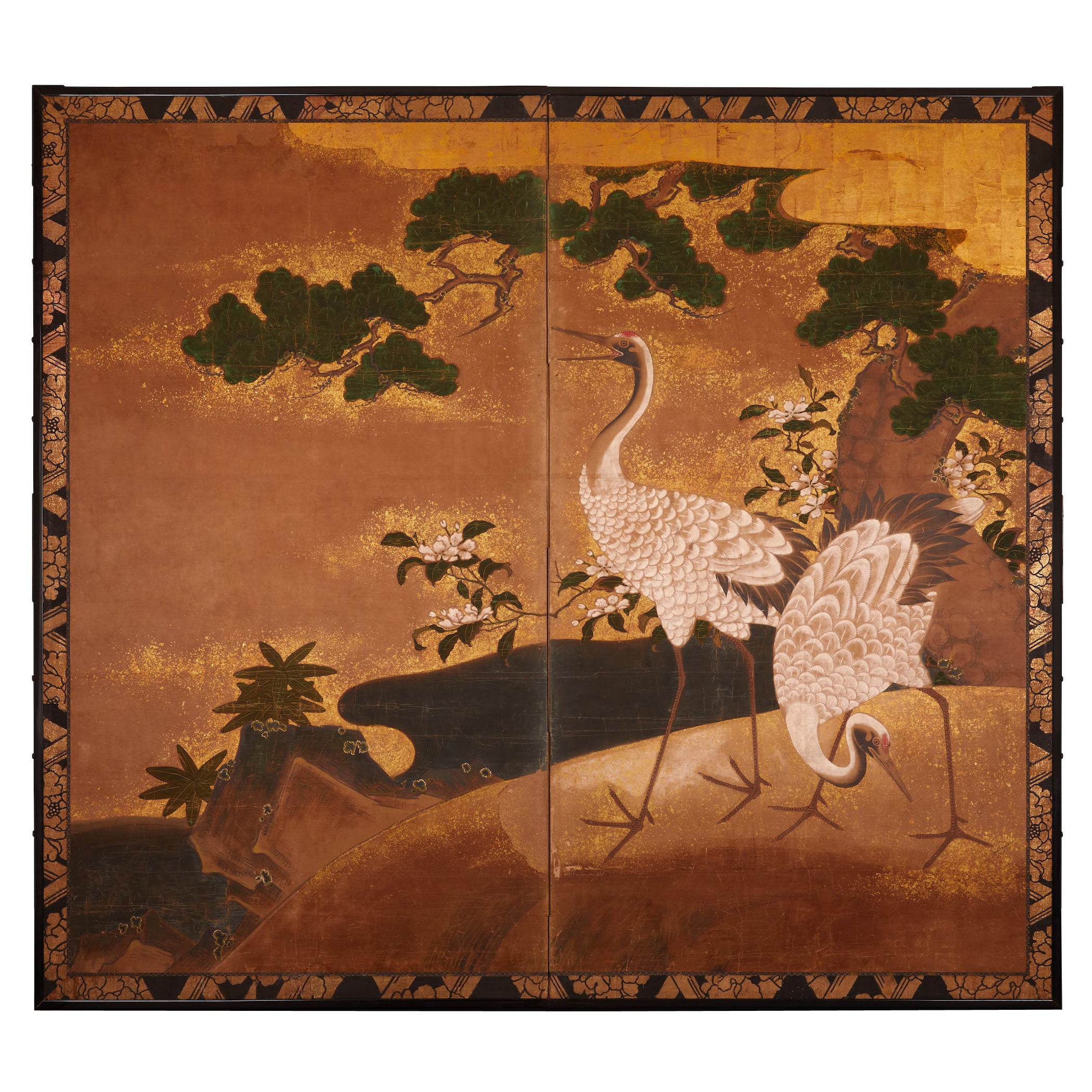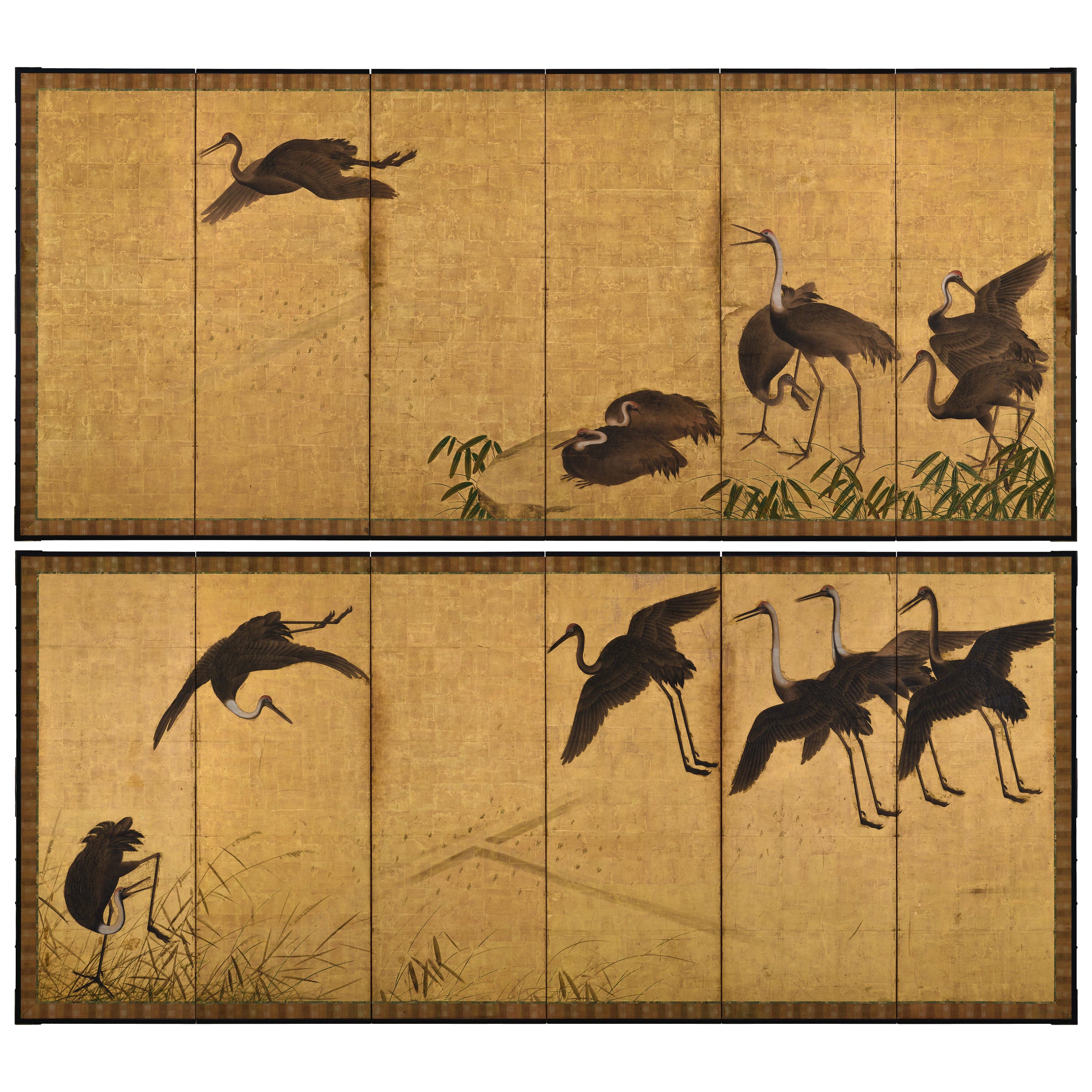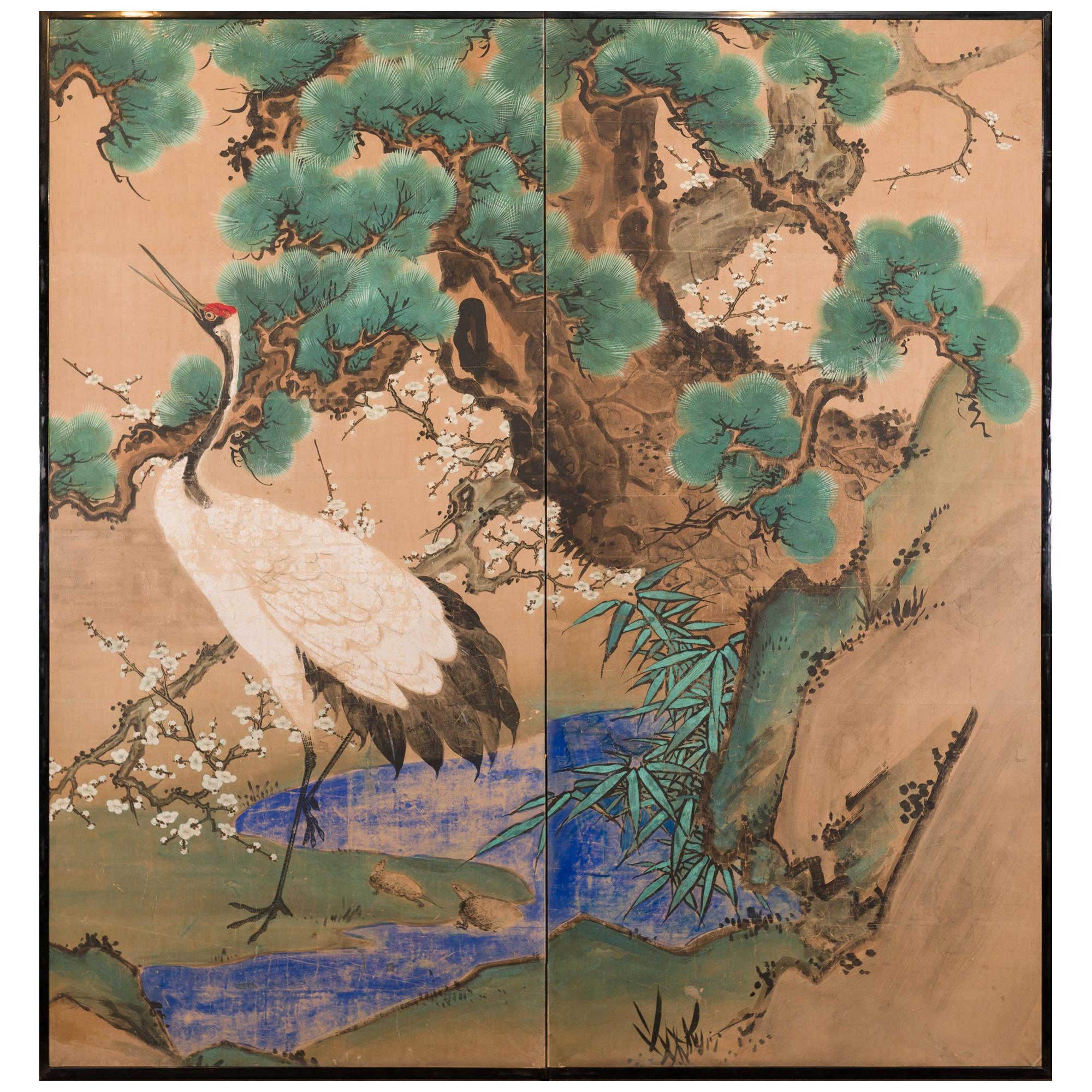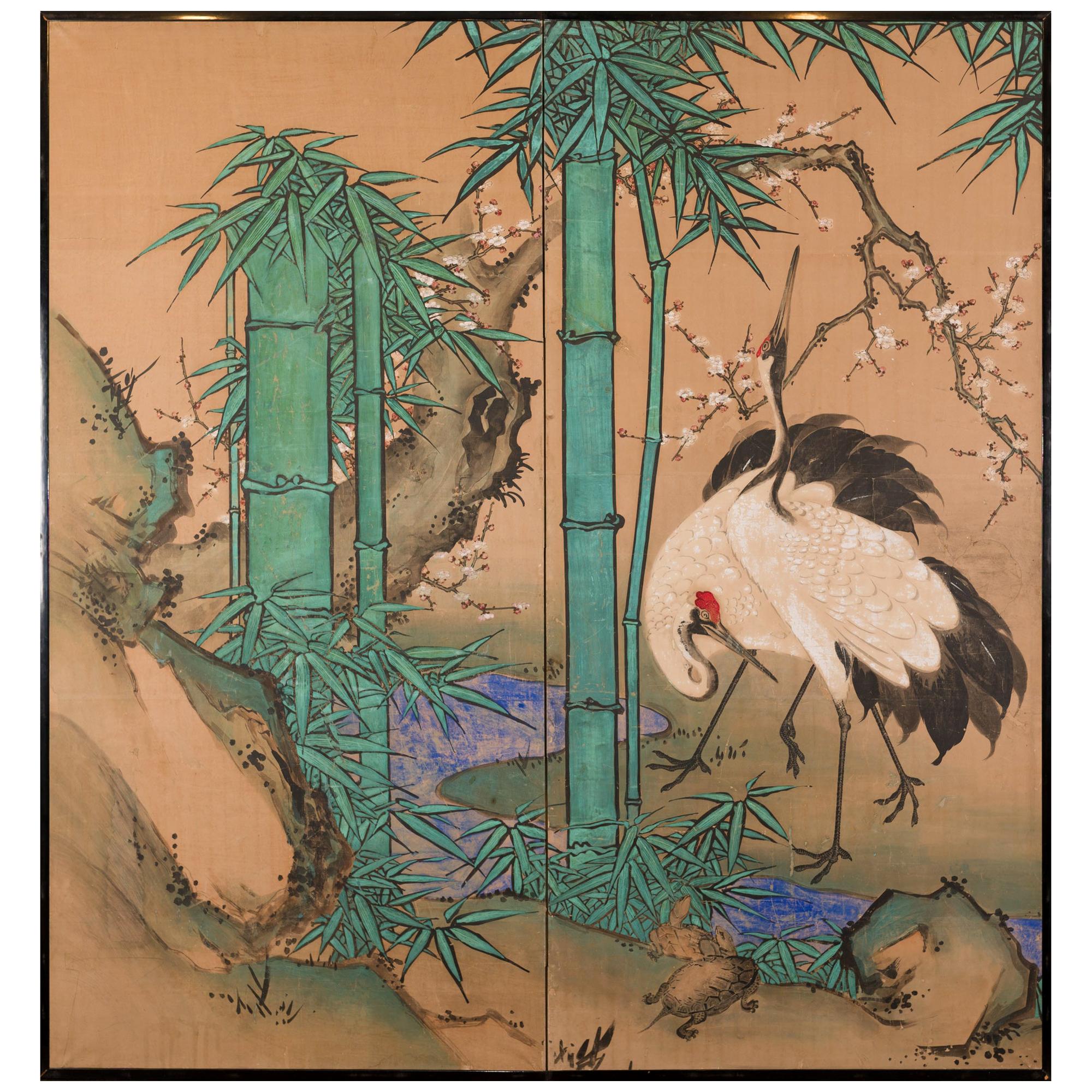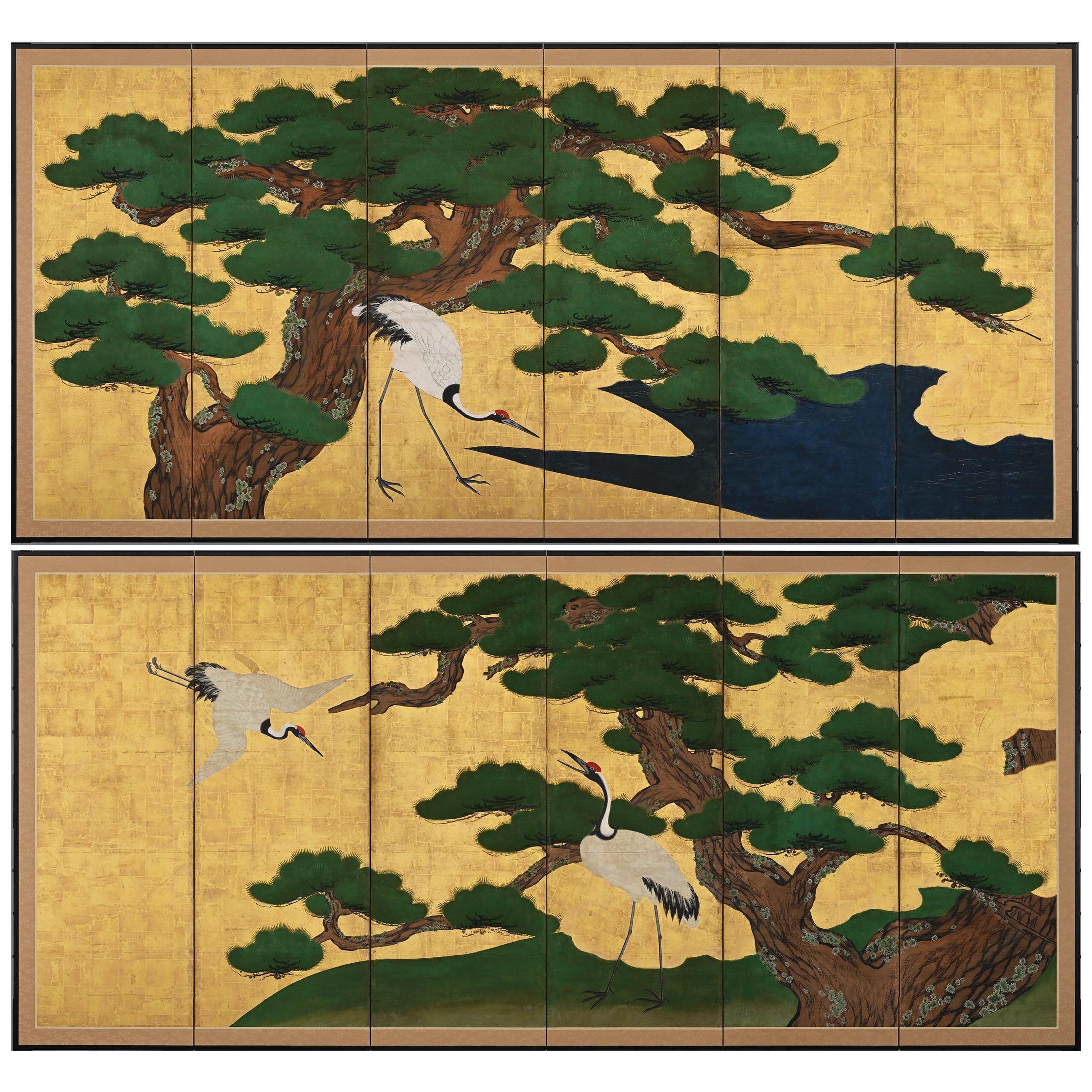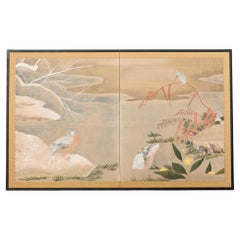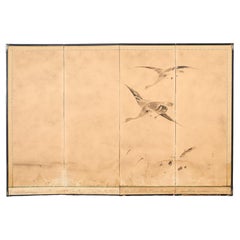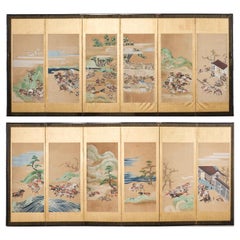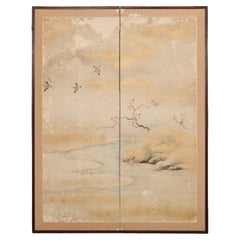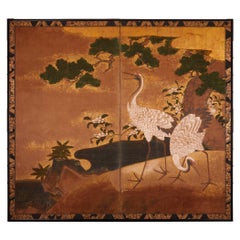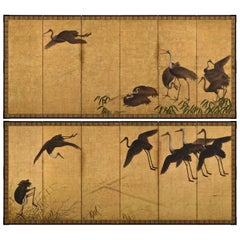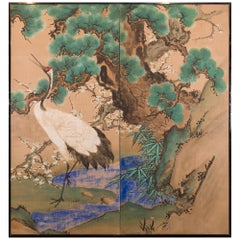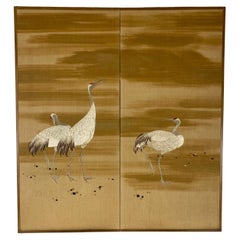Items Similar to Pair of Japanese Meiji Six Panel Screen Cranes Above Cresting Waves
Video Loading
Want more images or videos?
Request additional images or videos from the seller
1 of 22
Pair of Japanese Meiji Six Panel Screen Cranes Above Cresting Waves
$40,000per set
£30,204.32per set
€34,822.68per set
CA$56,457per set
A$62,233.06per set
CHF 32,563.30per set
MX$763,580.16per set
NOK 409,907.40per set
SEK 383,328.24per set
DKK 259,940.88per set
About the Item
Amazing 19th century pair of large Japanese Meiji period six panel screens each depicting a sedge of Manchurian red-crowned cranes along the shore. The screens are crafted in the Nihonga school style with intricate details and beautifully depicted cresting waves. Each screen is signed by artist Hakundo Keikan and studio name of Watahiki Tokai (Japanese 1837-1915). Both screens are signed with red seals on the left and right side. Tokai was a Chinese scholar from the late Edo period and served in the Imperial Household Ministry. Impressive large scale screens from an estate in San Francisco, CA. Sold as a pair. More photos and extensive video available upon request.
- Dimensions:Height: 66.5 in (168.91 cm)Width: 147.5 in (374.65 cm)Depth: 0.75 in (1.91 cm)
- Sold As:Set of 2
- Style:Meiji (Of the Period)
- Materials and Techniques:
- Place of Origin:
- Period:
- Date of Manufacture:Late 19th Century
- Condition:Repaired: old repairs. Wear consistent with age and use. Minor losses. Minor fading. Beautifully crafted with age appropriate wear and fading. The frames have solid joinery and construction. Old repairs as seen from reverse side. Minor foxing, losses, stains, and wear to silk border as seen in photos.
- Seller Location:Rio Vista, CA
- Reference Number:1stDibs: LU1555239554152
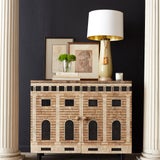
About the Seller
5.0
Erin Lane Estate is based in the San Francisco Bay Area, and its team of furniture restorers, art curators, professional appraisers and Asia specialists sources prime vintage and antique furniture from the finest estates in Northern and Southern California. Erin Lane Estate specializes in Hollywood Regency, McGuire, Chinese and Japanese pieces.
Diamond Seller
Premium sellers with a 4.7+ rating and 24-hour response times
Established in 2000
1stDibs seller since 2015
3,043 sales on 1stDibs
Typical response time: 2 hours
- ShippingRetrieving quote...Shipping from: Rio Vista, CA
- Return Policy
Authenticity Guarantee
In the unlikely event there’s an issue with an item’s authenticity, contact us within 1 year for a full refund. DetailsMoney-Back Guarantee
If your item is not as described, is damaged in transit, or does not arrive, contact us within 7 days for a full refund. Details24-Hour Cancellation
You have a 24-hour grace period in which to reconsider your purchase, with no questions asked.Vetted Professional Sellers
Our world-class sellers must adhere to strict standards for service and quality, maintaining the integrity of our listings.Price-Match Guarantee
If you find that a seller listed the same item for a lower price elsewhere, we’ll match it.Trusted Global Delivery
Our best-in-class carrier network provides specialized shipping options worldwide, including custom delivery.More From This Seller
View AllJapanese Showa Two Panel Screen Ducks in Winter Landscape
Located in Rio Vista, CA
Serene Japanese Showa period two panel byobu screen featuring two ducks and kingfisher in a late fall/early winter landscape. Crafted with ink and natural pigment colors on hand-craf...
Category
20th Century Japanese Showa Paintings and Screens
Materials
Silk, Wood, Paper
Japanese Meiji Four Panel Screen Wild Geese Over Reeds
Located in Rio Vista, CA
Muromachi period inspired Japanese four panel byobu screen depicting wild geese in flight over reeds. The 19th century Meiji period painting bears an artist's signature Chisokuken. C...
Category
Antique 19th Century Japanese Meiji Paintings and Screens
Materials
Brass
Pair of Japanese Edo/Tokugawa Screens Tale of Heiki
Located in Rio Vista, CA
Monumental pair of late 18th century Japanese Edo/Tokugawa period byobu screens depicting the battles between Taira and Minamoto. The screens have six panels each with individual sce...
Category
Antique 19th Century Japanese Edo Paintings and Screens
Materials
Brass, Gold Leaf
Japanese Edo Two Panel Screen Meandering Stream with Birds
Located in Rio Vista, CA
Weathered Japanese late 18th century Edo period two-panel byobu screen depicting a meandering stream with sparrows in flight. Crafted with natural ink and color pigments on mulberry ...
Category
Antique 18th Century Japanese Edo Paintings and Screens
Materials
Brass
Japanese Meiji Two Panel Screen Geese and Reeds
Located in Rio Vista, CA
Fantastic Japanese late Meiji period two-panel byobu screen by Hashimoto Koshu. The large screen features two white geese amid brightly colored reeds. The symbolism of geese and reeds was introduced to Japan from China in the 13th century. This was a popular subject for Japanese zen artists of the period. Beautifully crafted with exceptional brush strokes and details. Made with natural pigments in dramatic vivid colors of white, pink, and mint green on a silk background of gilt. Circa 1900 with artist seal on bottom right corner. Koshu studied Western art under...
Category
20th Century Japanese Meiji Paintings and Screens
Materials
Silk, Wood, Paper
Japanese Style Four Panel Screen Bamboo Waterfall with Magpies
Located in Rio Vista, CA
Large Chinese four panel Japanese style byobu folding screen depicting a waterfall landscape. The scene is decorated with bamboo, colorful blue magpies, and crashing waves. Construct...
Category
20th Century Chinese Showa Paintings and Screens
Materials
Brass
You May Also Like
Japanese Two-Panel Screen: Cranes on Gold
Located in Hudson, NY
Early Kano School painting of pine trees overlooking two beautifully painted cranes and floral design in a natural setting by water’s edge. Mineral pig...
Category
Antique Late 18th Century Japanese Paintings and Screens
Materials
Gold, Gold Leaf
17th Century Japanese Screen Pair. Flock of Cranes. Ink and color on gold leaf.
Located in Kyoto, JP
A pair of six-fold Japanese screens from the 17th century depicting a flock of cranes arriving at their wintering grounds. The expansive scene is heavily atmospheric. The cranes are...
Category
Antique 17th Century Japanese Edo Paintings and Screens
Materials
Gold Leaf
Japanese Two Panel Screen Manchurian Crane and Turtles
Located in Hudson, NY
In Japan, cranes symbolize fidelity as they mate for life and turtles symbolize longevity. Additionally, this screen also has the Japanese motif of sho-chiku-bai, or the three friends of winter (pine, plum, and bamboo). So called the three friends of winter because all three flourish during the cold months. This screen was originally fusuma doors...
Category
Antique Mid-19th Century Japanese Edo Paintings and Screens
Materials
Paper
Asian Folding Hand Woven Screen of Cranes
Located in Denton, TX
Asian Folding Hand Woven 2 Panel Screen of Cranes.
Category
Mid-20th Century Japanese Anglo-Japanese Tapestries
Materials
Thread
Japanese Two Panel Screen Amorous Cranes and Turtles
Located in Hudson, NY
Japanese two panel screen: Amorous Cranes and Turtles. In Japan, cranes symbolize fidelity as they mate for life and turtles symbolize longevity. Additionally, this screen also has the Japanese motif of sho-chiku-bai, or the three friends of winter (pine, plum, and bamboo). So called the three friends of winter because all three flourish during the cold months. This screen was originally fusuma doors...
Category
Antique 1850s Japanese Edo Paintings and Screens
Materials
Wood, Paper
Circa 1700 Japanese Screen Pair, Cranes & Pines, Kyoto Kano School
Located in Kyoto, JP
Pines and Cranes
Anonymous. Kyoto Kano School.
Late 17th/early 18th centuries, circa 1700.
Pair of six-panel Japanese folding screens.
Ink, gofun, pigment and gold leaf on paper.
This bold composition presents two pine trees extending to the left and right across a gold leaf background. One tree is silhouetted against a green ground, golden clouds obscuring its true size, the other stretches across a stylized waterway. The pines are paired with Manchurian cranes with red crests and snow white plumage. Both have been highly auspicious motifs in East Asia since Chinese antiquity. Here the artist utilized fluid and instinctive ink brushstrokes to define the trunk, branches and tail feathers, in strong contrast to the precision and sharp angularity of the crane’s legs and beaks. The adoption of this vast metallic painting support required an unerring sense of design and composition, so that the negative space surrounding motifs could imply context for the otherwise floating pictorial elements. The brushwork detailing the trunks of the pines, the exaggerated dimensions of the pine trees and the strength and dynamism of the composition are all reminiscent of Kano Eitoku...
Category
Antique Late 17th Century Japanese Edo Paintings and Screens
Materials
Gold Leaf
More Ways To Browse
Antique Crane
Antique Brass Panel
Pair Of Crane
Japanese Six Panel Screen
Pair Of Japanese Screens
Meiji Cranes
Asian Cranes
19th Century Chinese Painting On Silk
Antique Brass Painting
Nihonga Screens
Asian Brass Panels
Japanese 19th Century Meiji Period Silk Painting
Pair Of Chinese Cranes
Wood Crane
Asian Art Painting Pair Wood Panel
Japanese Crane Panel
Crane Screen
Red Cranes
